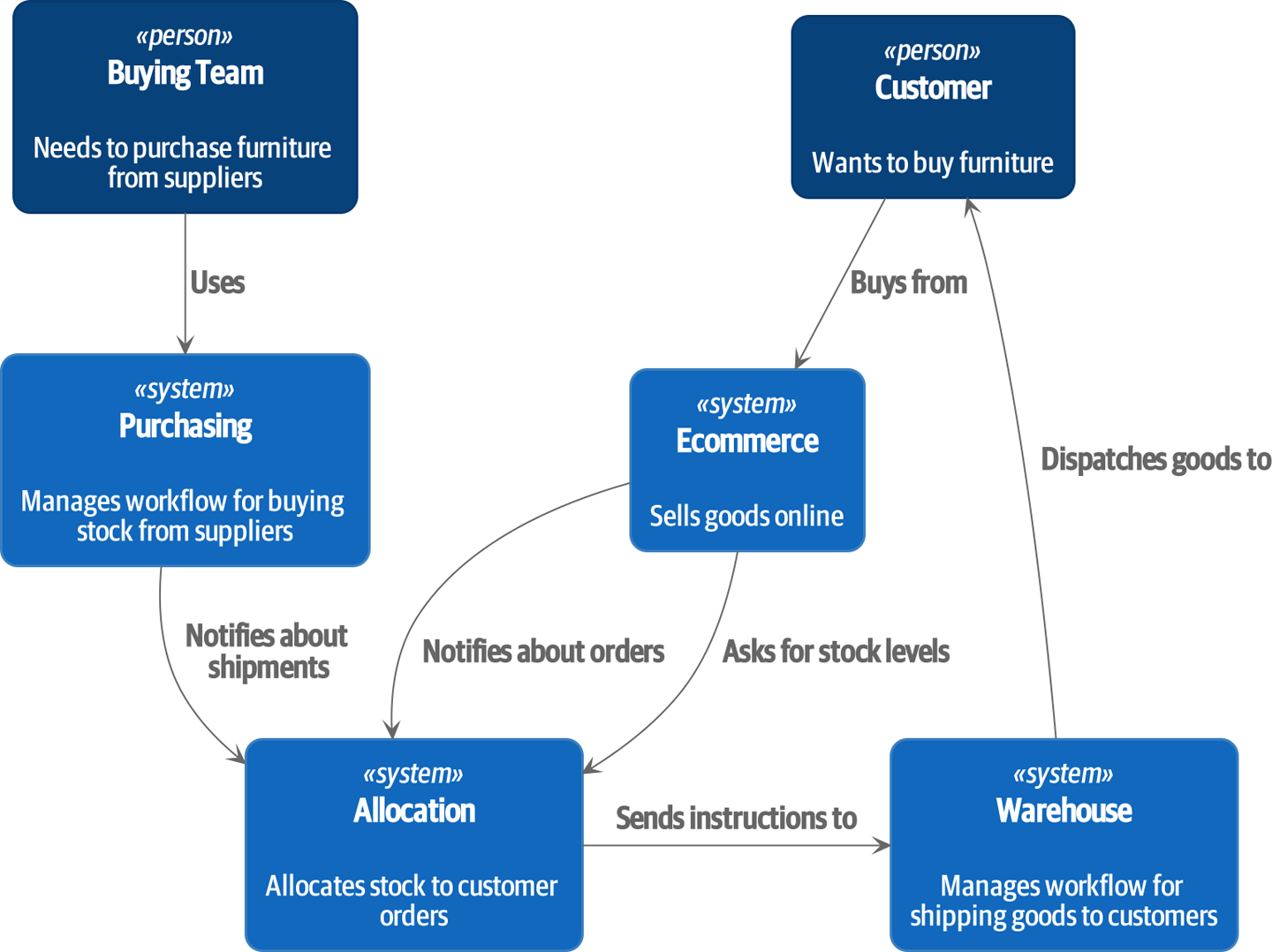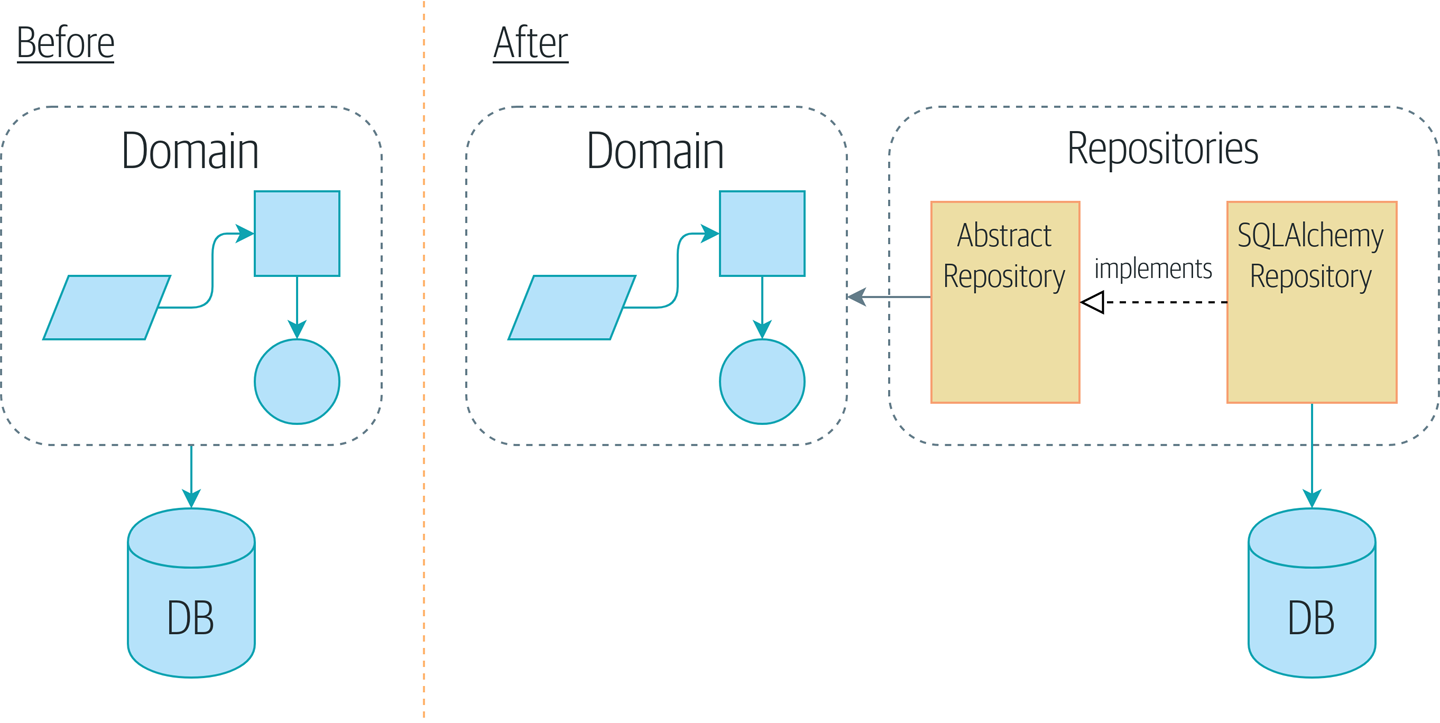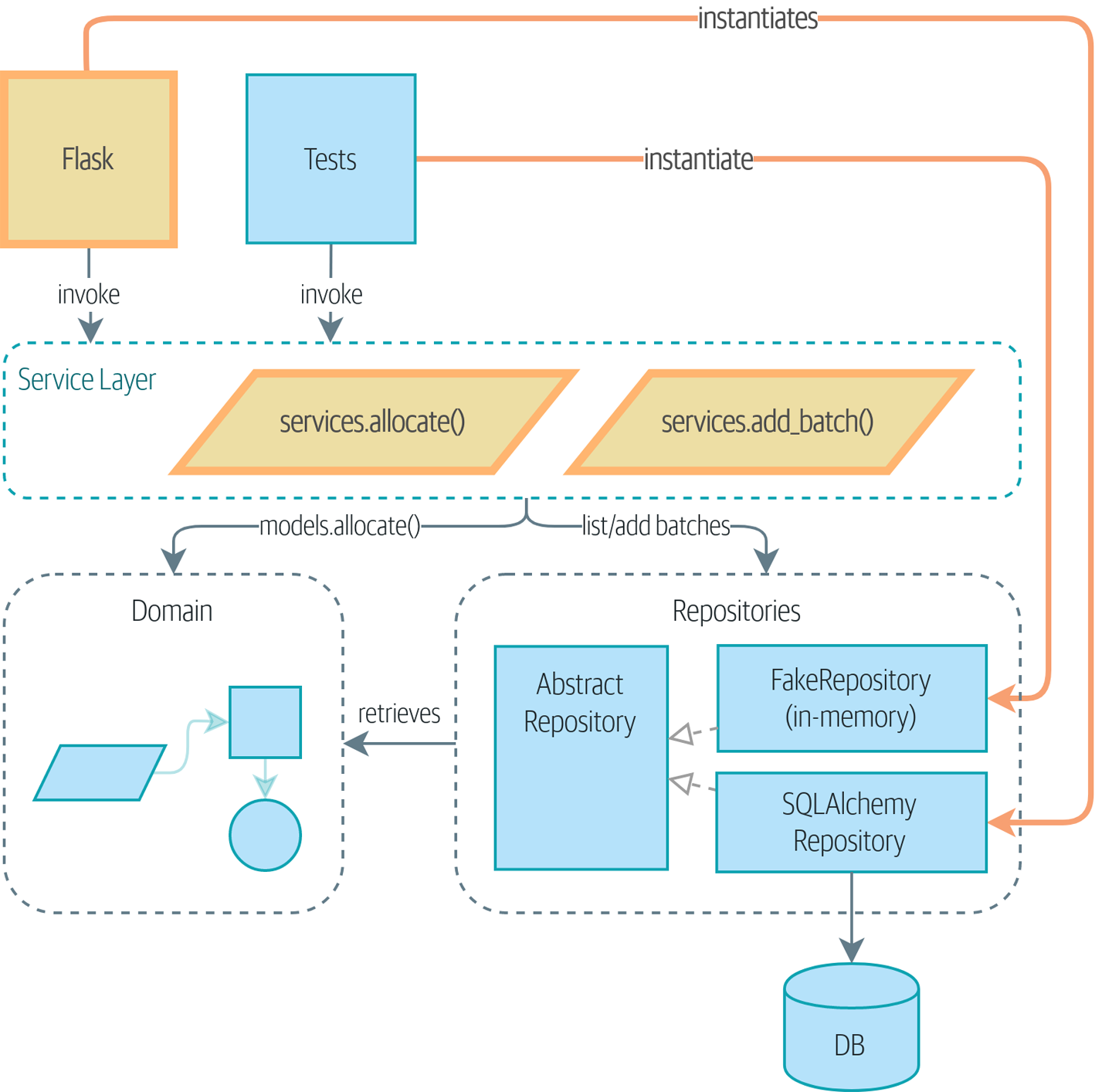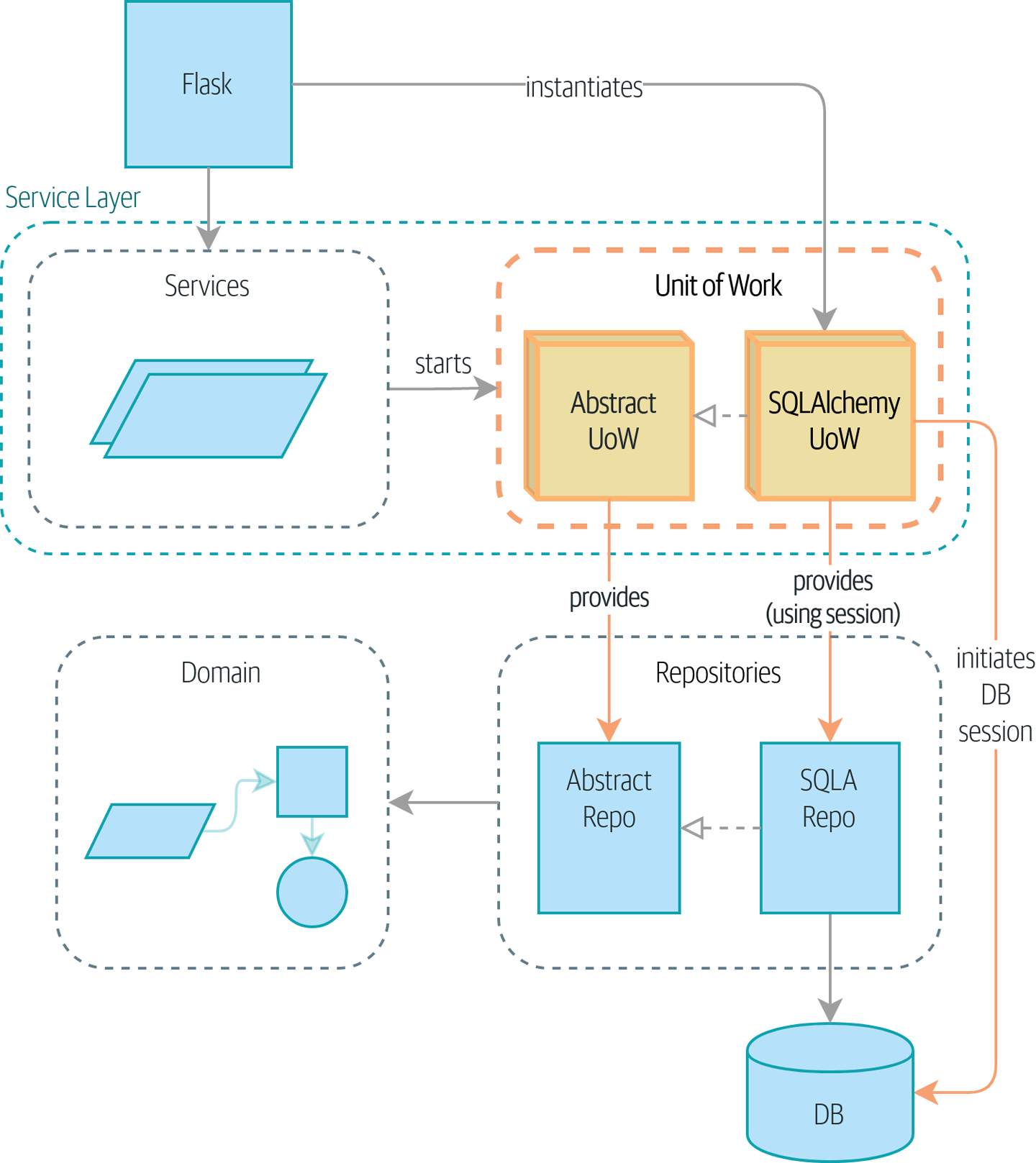A Project Template based on Cosmic Python Allocation service example.
At a high level, we have separate systems that are responsible for buying stock, selling stock to customers, and shipping goods to customers. A system in the middle needs to coordinate the process by allocating stock to a customer’s orders.
Apply dependency inversion to your ORM Our domain model should be free of infrastructure concerns, so your ORM should import your model, and not the other way around.
The Repository pattern is a simple abstraction around permanent storage The repository gives you the illusion of a collection of in-memory objects. It makes it easy to create a FakeRepository for testing and to swap fundamental details of your infrastructure without disrupting your core application.
Are these ports and adapters? Or is it hexagonal architecture? Is that the same as onion architecture? What about the clean architecture? What’s a port, and what’s an adapter? Why do you people have so many words for the same thing?
Ports and adapters came out of the OO world, and the definition we hold onto is that the port is the interface between our application and whatever it is we wish to abstract away, and the adapter is the implementation behind that interface or abstraction.
Concretely, in this chapter, AbstractRepository is the port, and SqlAlchemyRepository and FakeRepository are the adapters.
This pattern takes care of orchestrating workflows and defining use cases for the system. It will become the main way into the application, as it shows what the aim is.
Even though we are working with FastAPI instead of Flask, the same applies. Just replace Flask with FastAPI
See the Service Layer Trade-offs section for more details.
There are still some bits of awkwardness to tidy up:
The service layer is still tightly coupled to the domain, because its API is expressed in terms of OrderLine objects. In Chapter 5, we’ll fix that and talk about the way that the service layer enables more productive TDD.
The service layer is tightly coupled to a session object. In Chapter 6, e’ll introduce one more pattern that works closely with the Repository and Service Layer patterns, the Unit of Work pattern, and everything will be absolutely lovely. You’ll see!
As our application gets bigger, we’ll need to keep tidying our directory structure. The layout of our project gives us useful hints about what kinds of object we’ll find in each file.
Here’s one way we could organize things:
.
├── config.py
├── domain #(1)
│ ├── __init__.py
│ └── model.py
├── service_layer #(2
│ ├── __init__.py
│ └── services.py
├── adapters #(3)
│ ├── __init__.py
│ ├── orm.py
│ └── repository.py
├── entrypoints (4)
│ ├── __init__.py
│ └── flask_app.py
└── tests
├── __init__.py
├── conftest.py
├── unit
│ ├── test_allocate.py
│ ├── test_batches.py
│ └── test_services.py
├── integration
│ ├── test_orm.py
│ └── test_repository.py
└── e2e
└── test_api.py
- (1). Domain, from Domain Driven Architecture.
- (2). The service layer will be distinguished. What is the difference between a domain service and a service layer?
- Application service (our service layer) ts job is to handle requests from the outside world and to orchestrate an operation.
- Domain Service. This is the name for a piece of logic that belongs in the domain model but doesn't sit naturally inside a stateful entity or value object. For example, if you were building a shopping cart application, you might choose to build taxation rules as a domain service.
- (3). Adapters, it comes from ports and adapters terminology. This will fill up with any other abstractions around external I/O. Strictly speaking, you would call these secondary adapters or driven adapters, or sometimes inward-facing adapters.
- (4). Entrypoints are the places we drive our application from. In the official ports and adapters terminology, these are adapters too, and are referred to as primary, driving, or outward-facing adapters.
Many of our unit tests operate at a lower lever, closer to the domain model.
I was initially skeptical of all Bob’s architectural patterns, but seeing an actual test pyramid made me a convert.
Once you implement domain modeling and the service layer, you really actually can get to a stage where unit tests outnumber integration and end-to-end tests by an order of magnitude. Having worked in places where the E2E test build would take hours ("wait 'til tomorrow," essentially), I can’t tell you what a difference it makes to be able to run all your tests in minutes or seconds.
Read on for some guidelines on how to decide what kinds of tests to write and at which level. The high gear versus low gear way of thinking really changed my testing life.
Is it wrong to test against the domain model?
A test for the HTTP API tells us nothing about the fine-grained design of our objects, because it sits at a much higher level of abstraction. We can rewrite our entire application and, so long as we don't change the URL paths or request format, our tests will continue to pass.
At the other end of the spectrum, in previous chapters , tests helped us understand the objects we needed. Guiding us to a design that makes sense and reads in the domain language. When starting a new project or when hitting a particularly gnarly problem, we will drop back down to writing tests against the domain model, so we get better feedback and executable documentation of our intent.
The metaphor we use is that of shifting gears. When starting a journey, the bicycle needs to be in a low gear so that it can overcome inertia. Once we’re off and running, we can go faster and more efficiently by changing into a high gear; but if we suddenly encounter a steep hill or are forced to slow down by a hazard, we again drop down to a low gear until we can pick up speed again.
The Unit of Work pattern is a way to abstract over the idea of atomic operations. Allowing us to fully decouple the service layer from the data layer.
- The Unit of Work pattern is an abstraction around data integrity: It helps to enforce the consistency of our domain model, and improves performance, by letting us perform a single flush operation at the end of an operation.
- It works closely with the Repository and Service Layer patterns: The Unit of Work pattern completes our abstractions over data access by representing atomic updates. Each of our service-layer use cases runs in a single unit of work that succeeds or fails as a block.
- This is a lovely case for a context manager: Context managers are an idiomatic way of defining scope in Python. We can use a context manager to automatically roll back our work at the end of a request, which means the system is safe by default.
- SQLAlchemy already implements this pattern: We introduce an even simpler abstraction over the SQLAlchemy Session object in order to "narrow" the interface between the ORM and our code. This helps to keep us loosely coupled.
The UoW acts as a single entrypoint to our persistent storage, and it keeps track of what objects were loaded and of the latest state.
This gives us three useful things:
- A stable snapshot of the database to work with, so the objects we use aren’t changing halfway through an operation
- A way to persist all of our changes at once, so if something goes wrong, we don’t end up in an inconsistent state
- A simple API to our persistence concerns and a handy place to get a repository




